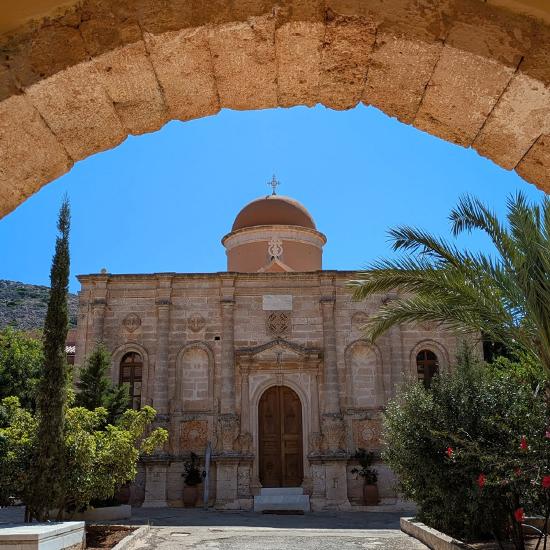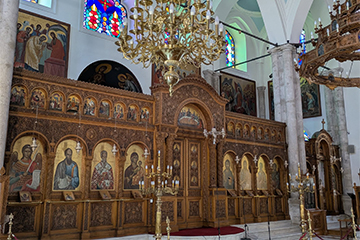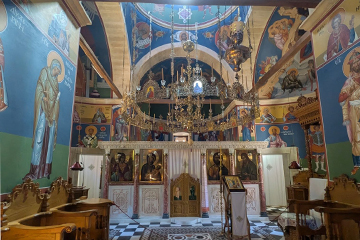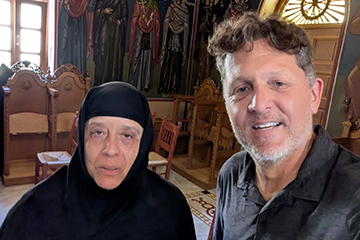Professor Dyron B. Daughrity Explores How Faith-Based Institutions Can Draw Inspiration from Cretan Monasteries

For centuries monasteries have preserved the island of Crete’s interwoven Christian tradition and complex cultural identity, capturing the interest of present-day church historians. This summer Dyron B. Daughrity, divisional dean of religion and philosophy and William S. Banowsky Chair in Religion, embarked on a research trip to Crete, visiting 22 Cretan monasteries—many still in operation—to study how their historical significance and ongoing theological traditions could positively influence contemporary faith-based institutions.
“The Christian university, with its roots in the monastery, has values that are notably reflected in Crete’s monastic tradition,” says Daughrity. “Monasteries hold Crete’s long and storied past that stand as global symbols of freedom, faith, and resilience.”
 Interior of the Cathedral of Saint Titus
Interior of the Cathedral of Saint Titus
Daughrity’s trip began in Heraklion, Crete’s capital and the site of the Cathedral of Saint Titus, which embodies the heart of Crete’s Christian tradition. Around AD 61-64 the Apostle Paul introduced Christianity to Crete, leaving behind his companion, Titus, whom Paul ordained as the first bishop of Crete. Paul needed Titus to organize the church there, and to address false teachings. The Heraklion cathedral was established in the 10th century under rule of the Byzantine empire and is dedicated to Titus, Crete’s patron saint.
“It is amazing to realize that the New Testament geography is still there for us to see,” says Daughrity. “It increases confidence in the glorious text that anchors our faith.”
Daughrity continued his travels to significant Cretan cities such as Agios Nikolaos, Rethymno, and Chania, visiting monasteries and interacting with monks and nuns in their daily work. Located near Chania, the Gouverneto Monastery, known as one of Crete’s oldest, was established in the 16th century when the Republic of Venice assumed control over Crete after the Fourth Crusade. The monastery is known for its distinct qualities of Venetian architecture and remains active today, housing 11 monks.
 Interior of the Gouverneto Monastery
Interior of the Gouverneto Monastery
“Here I visited with a monk who also serves as a medical doctor in a nearby clinic,” says Daughrity. “He is 32 years old, and has lived in the monastery for eight years. Amid busy monastery work, he takes care of a fellow monk that has ALS and another that has lung cancer. His acts of service, which embody Christ’s teachings, reflect a lifestyle lost to modern society. All the monks seem to really care about is Jesus Christ, the church, and their brotherly fellowship—and we need that. We need people among us whose whole life is God and His kingdom.”
Another notable Cretan monastery on Daughrity’s itinerary was the Monastery of Christ the Savior, located along the coast in Rethymno. In 1646 the monastery was completely destroyed when the Ottoman Empire overtook Crete, and it wasn’t rebuilt until 1935 when Nestoras Vassalos, a monk and well-known icon painter, had settled there after a vision that he had while at Mount Athos. Since then, the monastery has been functioning as a nunnery dedicated to bookbinding, literary pursuits, and the art of Byzantine iconography. Upon his visit, Daughrity was assigned an English-speaking nun to acquaint him with the convent’s operations.
 Daughrity with his newfound friend at Monastery of Christ the Savior
Daughrity with his newfound friend at Monastery of Christ the Savior
“After visiting the chapel, the nun hosting me asked me for a ride to her ailing father's house in Rethymno,” says Daughrity. “But we had to rush, as she feared the strict abbess might see her getting a ride with a man! As I only know Koine and modern Greek letters, she took the time to help me understand Byzantine Greek letters, and told me that she has been a nun since the age of 20. That’s 32 years! We were both excited to realize that we are the exact same age—52.”
Daughrity will purpose this monasticism research toward future book publications and articles. He plans to argue that Christian institutions—particularly Protestant ones—need to be aware of the monastic cultures within Christianity. Protestants operate without the internal scaffolding found in Catholic and Orthodox traditions, but they will benefit by understanding the church’s monastic heritage. Daughrity explains, “Understanding monastic forms of Christian faith will enhance our understanding of church history, and will enable us to preserve and strengthen our own Christian communities.”
In addition to his faculty position at Seaver College, Daughrity has authored and edited more than 20 books on the topics of global Christianity and church history, leads as general editor for several publications including the Bloomsbury Religion in North America project and the acclaimed series Christians in the City with Bloomsbury Academic. He also serves as senior minister for Hilltop Community Church in El Segundo.
“Receiving hospitality from the monks and nuns at Cretan monasteries while witnessing their acts of service was a special opportunity,” says Daughrity. “Through the continuation of actively studying, preserving, and interacting with church history we understand what it means to be a Christian university.”